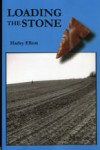Right away, Loading the Stone doesn’t seem to be typical Depraved Press fodder. A non-fiction book about arrowheads buried in the Kansas Flint Hills feels misplaced, lacking the progressive political agenda for which Thirdeye is known. But like the subject matter in this, Harley Elliott’s twelfth book and first collection of non-fiction, there exists below the surface universal binds and shared histories from which the impetus of progression can be said to reside.
The non-fiction moniker given to this collection belies the engaging, story-telling mode Elliott uses. Set against the backdrop of the Kansas prairie, Loading the Stone reads more like a story of a familial love of history used to explore the bonds threading father and son relationships than the listing of facts and dates that might be implied by the subject matter and genre. Perhaps, however, my assumptions of genre are just one example of the misunderstandings that Elliot explores. For example, the use of the word ‘Indian’:
The word had no relationship to the people [Christopher Columbus] encountered or the land they inhabited, or to the many generations preceding them, hunters of the big, antique bison and the mammoth. Nor did the word have any relationship to the generations to follow. It was a word that robbed identity, culture, and personality at once, too thin to cover the many varieties of humans it was assigned to describe. Walker grew up on the Hollywood version. [pg 18]
A strong theme running throughout this work is this idea of a misunderstood history, and Walker’s (our narrator) exploration of a truer history determined by the artifacts he uncovers during his walks among Kansas fields. Reflected in this understanding of history, is the bond being formed throughout the book by Walker and his father, and later Walker and his son. They commune over this enthusiasm; a relationship that suffers some turbulence about halfway through the book when our narrator first realizes that his son may not embrace flint the way he and his father have. It’s these moments of tension that beautifully keep Loading the Stone from being a tale of an isolated man connecting with the past — he is battling to connect for the sake of a future.
The book does delve heavily into flint and arrowhead terminology in a deeper way than most casual readers would appreciate. The entire center section of the book (61 out of the book’s 244 pages), for example, breaks from the promise of a fluid story supported by an academic skeleton to simply… well, the skeleton. This section called “The Rocking Deer Journal” appears to be a literal journal complete with lists, sketches, and meandering observations, which if delivered in a much smaller dose could have effectively developed both the intellectual nature of the story and the father of our narrator (as it is his journal). However, it comes across as redundant and worthy of just a skim through.
Good writing can engage a reader in most any subject matter; however, often times the reader should come to the text with a genuine interest in the subject. I’ve done my best to judge this book objectively, as I am not — before or after reading this book — a fan of flint. I do, however, respect the writer’s craft. As Walker says in reference to an initially awkward arrowhead: “being an artist sometimes meant recognizing the spirit of material and letting it stand” [pg 170]. Likewise, being a fan of art means recognizing the spirit of the artist.






Thank you for this review.
Positive mention of the Flint Hills always gets my attention! Thanks!
So happy it brought me to your site. Hope you and your readers visit regularly.
Our 22 county Flint Hills Tourism Coalition, Inc. promotes visits to the Kansas Flint Hills – the website is: http://www.kansasflinthills.travel/
Best wishes!
Dr. Bill 😉
Personal Blog: http://flinthillsofkansas.blogspot.com/